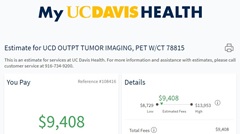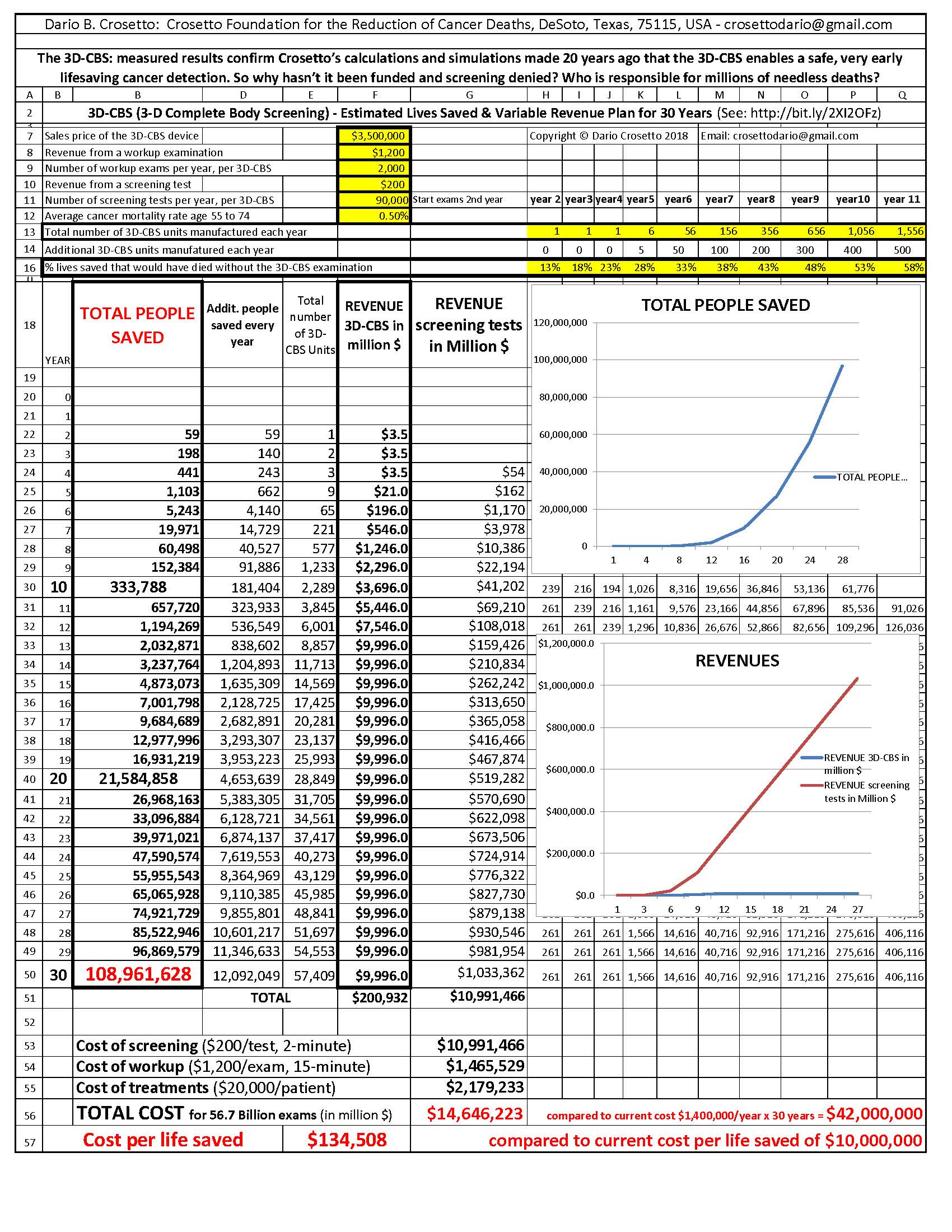
1. By funding projects that work and can prove their efficacy, showing a reduction in cancer deaths on a sample population in a specific area.
2. Early cancer detection can save up to 98% of lives with existing successful treatments.
3. Crosetto’s 3D-CBS invention capable of detecting at an early curable stage tumors with only 100 cancerous cells instead of a billion cells (1 cm3) exist since 21 years.
4. After boycotting his work, suppressing his publications and presentations at scientific conferences, his claim of detecting 100 cancerous cells has been confirmed by third parties on less efficient copies of the 3D-CBS.
5. However, the cost of the exam on these copies is $10,000 preventing a screening of a large population, while the exam on the 3D-CBS is only $200, enabling saving many lives.


6. Those who have boycotted and suppressed Crosetto’s work so far have played on the fact that the public believed their authoritarian word that it was not possible to detect small tumors with 100 cells, but in the end the experimental data proved that they were wrong after 19 years.
7. Now it’s up to us, the future is in our hands if we don’t want it to take another 20 years to prove Crosetto right in the calculations that the 3D-CBS exam costs only $200 and we don’t have to wait another 20 years to get the evidence that a screening test on existing machines, copies of the 3D-CBS prove that they save lives.
8. Everyone can make their own theories, guesswork, identify the culprit, the perpetrator who wastes taxpayers’ money, etc. but they are of no use if the inconsistencies and scientific truth are not disclosed. A donation of €10 can go a long way as the sponsorship on Facebook of the 300-word abstract (https://bit.ly/2Wchq3i) approved by a scientific conference, which summarizes how millions of lives and billions of Euros can be saved which in 10 days has reached over 100,000 people and received 2,400 likes.
9. Your donation, even a small one, and your word of mouth and sharing of this news is the contribution that will make science prevail for your benefit.
10. Galileo’s winning move was not to make scientific truth prevail by appealing to his fellow scientists and the decision makers, but to disclose it in the Dialogue Concerning the Two Chief World Systems in simple language understandable to the public.
11. Below I report the simple calculations understandable to a high school student about the determination of the price of $200 for a 3D-CBS exam. The verification that it saves lives can be performed on one of the copies, although less efficient and at a very high cost. The machine is now in existence, all we need is the will to save lives and then the will to reduce the price of the exam by 50 times to make this benefit affordable for everyone and save many lives.
The $200 screening test on the 3D-CBS is supported by the calculations reported below detailing the estimated cost of 48 employees required to perform nearly 360 x 2-minute screening tests and 8 x 15-minute clinical exams per day during two 8-hour shifts, the cost of the radioisotope, the cost of the maintenance and depreciation of the device, the rent of office space and profit totaling $58,480/day.
The 1-minute screening test + 1-minute in-out the bed for a throughput of 2-minute total, was performed daily in Shanghai, China. Measurements on copies of the 3D-CBS determined that one minute screening test was acquiring enough data (approximately 200 million signals from the tumor markers) to obtain images of diagnostic quality. The more efficient 3D-CBS can provide images of higher diagnostic quality by capturing in one minute more signals (250 million) administering a lower radiation to the patient.
The estimated number of employees is supported by the following criteria, however, it might change in a different environment of hospital, clinic, imaging center, etc. This estimate is just providing a feasibility study with an approximate cost.
Setting the price of the 2-minute screening test at $200 and the 15-minute workup clinical examination at $1,200 will provide an income of $81,600/day leaving $23,120/day for extra items and/or hospital profit. Customers can purchase several 15-minute slots for patient clinical use or for research. The study envisions requiring the following material, capital amortization and professionals earning the estimated salary listed below:
Each shift will perform
For a total of 8 hours per shift.
360 screening tests/day in two shifts x $200 = $72,000/day
8 workup-clinical examinations/day in two shifts x $1,200 = $9,600/day
For a Total income per day of $81,600/day
Personnel for organizing the screening of 90,000 people per year:
Personnel for each 8-hour shift:
Reading results from 2-minute screening tests performed at $200 each on the 3D-CBS device requires less time than reading data of a clinical examination of the whole body.
In one daily shift of 7-hour work + 1-hour meal-break, six doctors are expected to read 18-20 screening tests for 22 minutes each, and four doctors are expected to read 16 screening tests for 22 minutes each and one clinical exam for 68 minutes. People must perform several screening tests on the same machine, using the same protocol and the same radiation dose (plus/minus the percent of the weight gained or lost).
To avoid false positives, the diagnosis will not be based on a single screening test but on the experience by the radiologist reading the trend of anomalies in several screening tests.
The first screening test does not provide meaningful information unless there is something major that lights up, it simply provides a baseline for future tests. Subsequent screenings determine if there are unique hot spots that light up compared to the previous screening test that require further investigation.
Repeated screening tests at one year, six months, three months, or shorter intervals that show increased activity and size of an anomalous biological process require scheduling a deeper investigation with a 15-minute slot of a clinical examination costing $1,200 each.
Screening tests before and several after surgery at two, three, six months intervals, detect if some cancer cells have been left over and monitor for recurrences at an early curable stage.
Personnel for each 8-hour shift:
Reading results from 2-minute screening tests performed at $200 each on the 3D-CBS device requires less time than reading data of a clinical examination of the whole body.
In one daily shift of 7-hour work + 1-hour meal-break, six doctors are expected to read 18-20 screening tests for 22 minutes each, and four doctors are expected to read 16 screening tests for 22 minutes each and one clinical exam for 68 minutes. People must perform several screening tests on the same machine, using the same protocol and the same radiation dose (plus/minus the percent of the weight gained or lost).
To avoid false positives, the diagnosis will not be based on a single screening test but on the experience by the radiologist reading the trend of anomalies in several screening tests.
The first screening test does not provide meaningful information unless there is something major that lights up, it simply provides a baseline for future tests. Subsequent screenings determine if there are unique hot spots that light up compared to the previous screening test that require further investigation.
Repeated screening tests at one year, six months, three months, or shorter intervals that show increased activity and size of an anomalous biological process require scheduling a deeper investigation with a 15-minute slot of a clinical examination costing $1,200 each.
Screening tests before and several after surgery at two, three, six months intervals, detect if some cancer cells have been left over and monitor for recurrences at an early curable stage.
For a total per shift of $2,760/h x 8 h = $22,080 x 2 = $44,160/day
Cost of the radioisotope $5,000/day
Cost of the maintenance of the 3D-CBS is typically 15% of its value of $3,500,000 = $525,000/250 days $2,100/day
Cost of rental space in the building $1,220/day
Cost of 3D-CBS device amortization (4.5 years) $3,600/day
These costs which refer to average salaries and cost of products in the United States total a daily cost of approximately $58,480 a day, however for the same number of screening tests and clinical examinations in India the daily cost could decrease to $40,000 a day, while for Switzerland it could increase to $70,000 a day. Obviously, by analyzing the case on a specific territory, the values of salaries and products available in the specific location will be introduced into the table. http://bit.ly/2XI2OFz

Diagnosis will be based on CAD trends calculated on anomalies in biological processes detected by several whole-body screening test or examinations on the 3D-CBS with long FOV, rather than on a single test or examination. This can save millions of lives and trillions of dollars not only from cancer diseases but for many other diseases.
The CAD is analyzing images from different screening tests and/or examinations of the same patient that were performed on the same device, in the same conditions, with the same protocol, with the same radioisotope and the same radiation dosage (plus/minus the percent of the weight gained or lost).
The first screening test does not provide meaningful information unless there is something major that lights up, it simply provides a baseline for future tests or examinations. Subsequent screenings reveal unique hot spots showing increased activity/size of an anomalous biological process requiring deeper investigation (15-minute clinical examination).
Screening tests before/after surgery detect if any cancer cells have been left over and monitor for recurrences at an early curable stage.
The mind of the doctor has to correlate and consider many parameters that CAD cannot correlate but computers are improving efficiency by reading data from tests and examinations automatically detecting lesions in medical images.
The CAD system aid the detection, characterization, diagnosis and assessment of anomaly biological processes vs. normal.
The computer CAD shows both, the classification output as well as images of the lesions with known diagnosis and the extracted features.
The radiologist can choose to compare a single feature or multiple features with a database of similar lesions, or the computer can estimate based on the trend of multiple tests or examinations on the same patient the likelihood of malignancy.
The CAD system calculates the features of trend of the patient under test and compares it with the trends of similar cases with a similar index. The CAD system displays the distribution curves of the known similar cases and the probability distribution curves of the case under test.
In summary, the CAD (Computer-Aided Diagnosis) system help to understand abnormal anatomical density of the tissues and abnormal biological processes in the patient’s body that help to diagnosis, the huge relational database of information and the possibility to query, find inconsistencies and matching conditions gives the choice and power to the CAD user to provide information for a prognosis and treatment.
RESEARCH STUDY ON THE 3D-CBS WILL SHOW
EACH DEVICE CAN SAVE OVER 260 LIVES PER YEAR
AT 1/80th THE CURRENT COST PER LIFE SAVED,
WITH THE POTENTIAL TO SAVE OVER 100 MILLION LIVES
AND OVER $27 TRILLION IN 30 YEARS
Taking as reference experimental data confirmed by WHO (World Health Organiz.), NCI (National Cancer Institute) and ACS (American Cancer Society) as well as many universities that cancer has a survival rate of up to 98% when detected at an early stage, and assuming a conservative figure for the 3D-CBS to offer a success rate above 58%, then each 3D-CBS device is expected to save over 260 lives each year, according to the calculations described below.
Assuming the death rate in the age group 55 to 74 for the past 20 years is 0.5% in the location where the testis planned (this data can be verified), then of the 90,000 individuals, 450 are expected to die.
If we apply the factor 58% survival rate due to early detection with the 3D-CBS device combined with successful treatment, each year the 3D-CBS device could save over 260 lives (450 x 58% = 261).
In the table reported below, which estimates how many lives can be saved as well as cost savings during the next 30 years, I have used a more conservative estimate on the number of lives saved during the first years starting at 13% and increasing to 58% after 10 years of screening a population in a specific area.
The data in the table reported below is useful for a comparison with the current estimate by WHO, NCI and ACS, that cancer deaths will double in the next 20 years. Instead, during the next 30 years with the 3D-CBS, over 100 million lives and over $27 Trillion would be saved (http://bit.ly/2XI2OFz).
The cost per life saved will drop from the current $10 million cost per life saved to $134,508 using the 3D-CBS, which provides a cost-effective cancer screening, combined with successful treatments when cancer is detected at an early curable stage.
My basic 3D-Flow invention which breaks the speed barrier in real time applications and provides staggering advantages in many fields/functions, in particular in Medical Imaging PET (Positron Emission Tomography) devices, reducing radiation to 1% and enabling an effective early cancer detection, was recognized valuable by academia, industries and research centers in an official, formal, international public scientific review held at FERMILAB. It received $1 million in grants that allowed to provide results published in a prestigious peer-review scientific journal (goo.gl/bqhD4R).
In the year 2000, I invented the 3D-CBS (3-D Complete Body Screening) that creates a paradigm change in Biomedical Imaging. I deposited the blueprint design (goo.gl/ggGGwF) in the U.S. Library of Congress, and patented it to encourage investors to build and recoup their investments.
In 2011, it won the Leonardo da Vinci Prize for the most efficient solution for early cancer diagnosis, held at the University of Pavia, Italy, and was proven functional in hardware circuits. The entire 3D-CBS project targeted to save lives through an effective early detection has been proven feasible by 59 quotes from reputable industries (goo.gl/w3XlZ1) but has never been funded.
The EXPLORER mainly targeted to develop new drugs to increase the cancer business, built 15 years later, which is essentially a copy of the 3D-CBS has a cost per good photon pairs captured 44 times the cost on the 3D-CBS, requires 7 times the radiation dose and/or 7 times the duration of the examination, which increases the cost of the exam.
Graph of the estimated lives saved and revenues plan for 30 years when using the 3D-CBS device. In the background is the table from which the graphs have been generated that can be accessed and modified interactively at: http://bit.ly/2XI2OFz.
This table is a very powerful tool to design a strategic plan for different devices (EXPLORER, 3D-CBS, Siemens Biograph Vision Quadra, etc.), products, vaccines, drugs, or procedures, and calculate the efficacy over 30 years for the proposed claimed reductions in cancer deaths and costs estimated theoretically in row 16.
As measurements are performed year after year on real devices and by implementing the proposed test protocol, values in row 16 are corrected providing a more accurate estimate of the total number of lives and costs saved in 30 years.
The user of this table needs to introduce the values in rows 7, 8, 9, 10, 11, and 12, which are easy to determine from calculations referring to existing experimental data or products. Data introduced in row 13 estimating the total number of units manufactured each year to reach 57,000 units in 30 years might face the same skepticism as COVID-19 faced last year.
However, when the world realizes the importance and urgency of saving millions of lives, even the most challenging problems are solved.
If in less than one year several companies were able to produce billions of COVID-19 vaccines, masks, and PPEs, the problem of producing 57,000 3D-CBS units would be a comparatively easy job.
